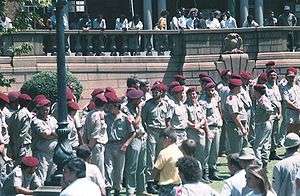Battle of Ventersdorp
| Battle of Ventersdorp | |||||||
|---|---|---|---|---|---|---|---|
| Part of Negotiations to end apartheid in South Africa | |||||||
 AWB Rally, Church Square, Pretoria in 1990. | |||||||
| |||||||
| Belligerents | |||||||
|
|
| ||||||
| Commanders and leaders | |||||||
|
|
| ||||||
| Strength | |||||||
| 2,000 | Unknown | ||||||
| Casualties and losses | |||||||
|
3 dead 13 injured |
6 policemen injured 29 civilians injured One passer-by killed | ||||||
The Battle of Ventersdorp on 9 August 1991 was a violent confrontation in the South African town of Ventersdorp between right wing supporters of the Afrikaner Weerstandsbeweging (AWB) and the South African Police and security forces. Though technically not a "battle", it became known as such in the media while official sources such as the Truth and Reconciliation Commission (TRC) simply refer to it as an "incident". Much of its notoriety lies in the fact that it was the first time in the 43 years of apartheid that police officers killed white protesters.
Background
The confrontation took place outside the Ventersdorp town hall where then State President F.W. de Klerk was scheduled to speak. At the time, right-wing resentment of De Klerk was running high following his unbanning of the African National Congress, releasing Nelson Mandela from prison the year before, and beginning negotiations to end apartheid. Amid violent right wing rhetoric and talk of Boer resistance, De Klerk's appearance in Ventersdorp, a right-wing stronghold and home town of AWB leader Eugène Terre'Blanche, became a flashpoint. The AWB called a protest in which the town was inundated by angry opponents of De Klerk, including armed paramilitary members of the AWB. The supporters had showed up from far and wide, even a group of angered White Namibian farmers joined in the mass protest. Weapons were confiscated at several police road- blocks near Ventersdorp.
Three months before on 11 May 1991, white armed AWB supporters led by Terre'Blanche clashed with police at the Ventersdorp farm of Goedgevonden, while attempting to force black squatters off the farm. They managed to break police lines and destroy several structures when police opened fire wounding four of them. They then proceeded to the nearby black township of Tshing attacking more houses before calm was restored by the Minister of Law and Order, Adriaan Vlok and Conservative Party deputy, Ferdi Hartzenberg.
Confrontation
The AWB supporters numbered 2,000. They were armed with hunting rifles and pistols and wore protective items to shield them from the effects of an inevitable tear gas attack by the riot police. The police equalled the AWB in number, but were considerably better trained and equipped.
Many unconventional tactics were employed by the AWB. They allegedly wore plaster of Paris on their limbs to protect them from police dogs. Video footage shows AWB members locking arms and carrying rags and vinegar to lessen the effects of tear gas.
Once the AWB cut the electricity and fired on the police, the police were ordered to shoot to kill. Three policemen were wounded, none of them fatally, while the police killed one AWB member. The AWB also fired into a police minibus. Two AWB members were killed and 13 were injured when the police returned fire from the minibus.
Terre'Blanche made a point of appearing in front on television cameras and said (in Afrikaans), "Where is De Klerk? I want to talk to him. He came here armed. Here lies a man on the ground and over there lies a man" (referring to injured policemen).
In all, three AWB members and one passer-by were killed. Six policemen, 13 AWB members, and 29 civilians were injured.
Aftermath
The growing conflict between right-wing groupings and the government has been identified as one of the most significant developments in the course of 1991, with the Battle of Ventersdorp as its high point.[1]
The events in Ventersdorp, as well as gains by the right-wing opposition in white by-elections, led De Klerk to call a referendum in March 1992. The referendum confirmed white support for the negotiation process, despite continued opposition from the far right.
Following the end of apartheid, Terre'Blanche and his supporters sought amnesty for the Battle of Ventersdorp and other acts. Amnesty was granted by the Truth and Reconciliation Commission.[2][3][4]
The three dead AWB members, A.F. Badenhorst, G.J. Koen and J.D. Conradie were honoured at an AWB ceremony in October 1994, in Ventersdorp. A monument still remembers their death.[5]
References
- ↑ Graeme Simpson & Janine Rauch (1993). Boister, N. & Ferguson-Brown, K, eds. "Political Violence: 1991". Centre for the Study of Violence and Reconciliation, Human Rights Yearbook 1992, First Edition. Cape Town: Oxford University Press: 212–239. Archived from the original on 19 August 2010. Retrieved 1 June 2008.
- ↑ "Amnesty decision AC/99/0221". Truth and Reconciliation Commission. 1999. Retrieved 11 October 2006.
- ↑ "Amnesty hearing". Truth and Reconciliation Commission. 11 May 1999. Retrieved 25 April 2007.
- ↑ "Terre'Blanche calls for De Klerk to answer at his amnesty hearing". SAPA. 11 May 1999.
- ↑ Rory Carroll (10 May 2004). "Terre'Blanche returns to a new world". Manchester Guardian. Retrieved 17 November 2008.